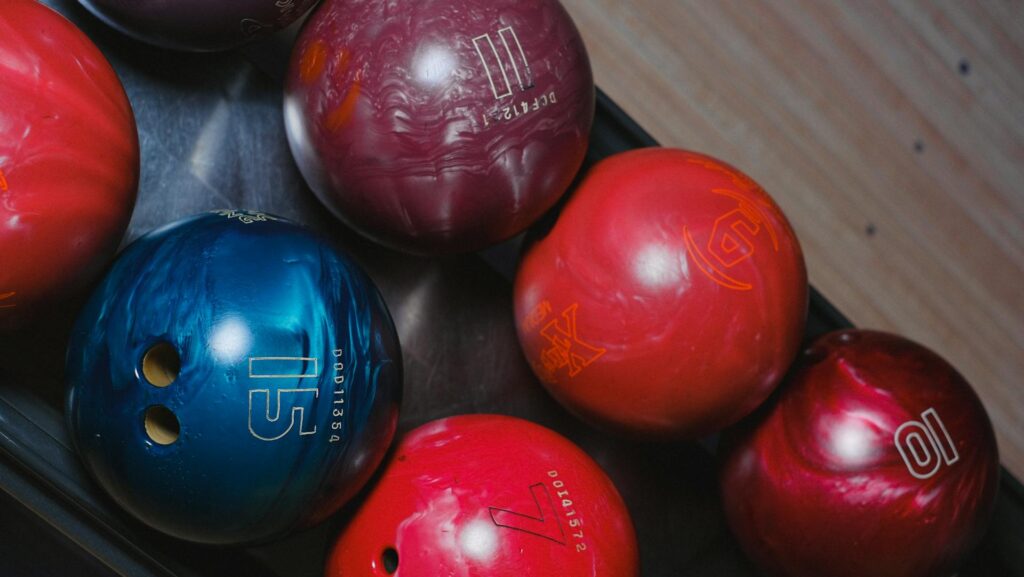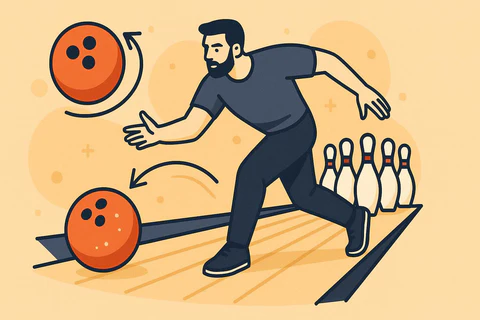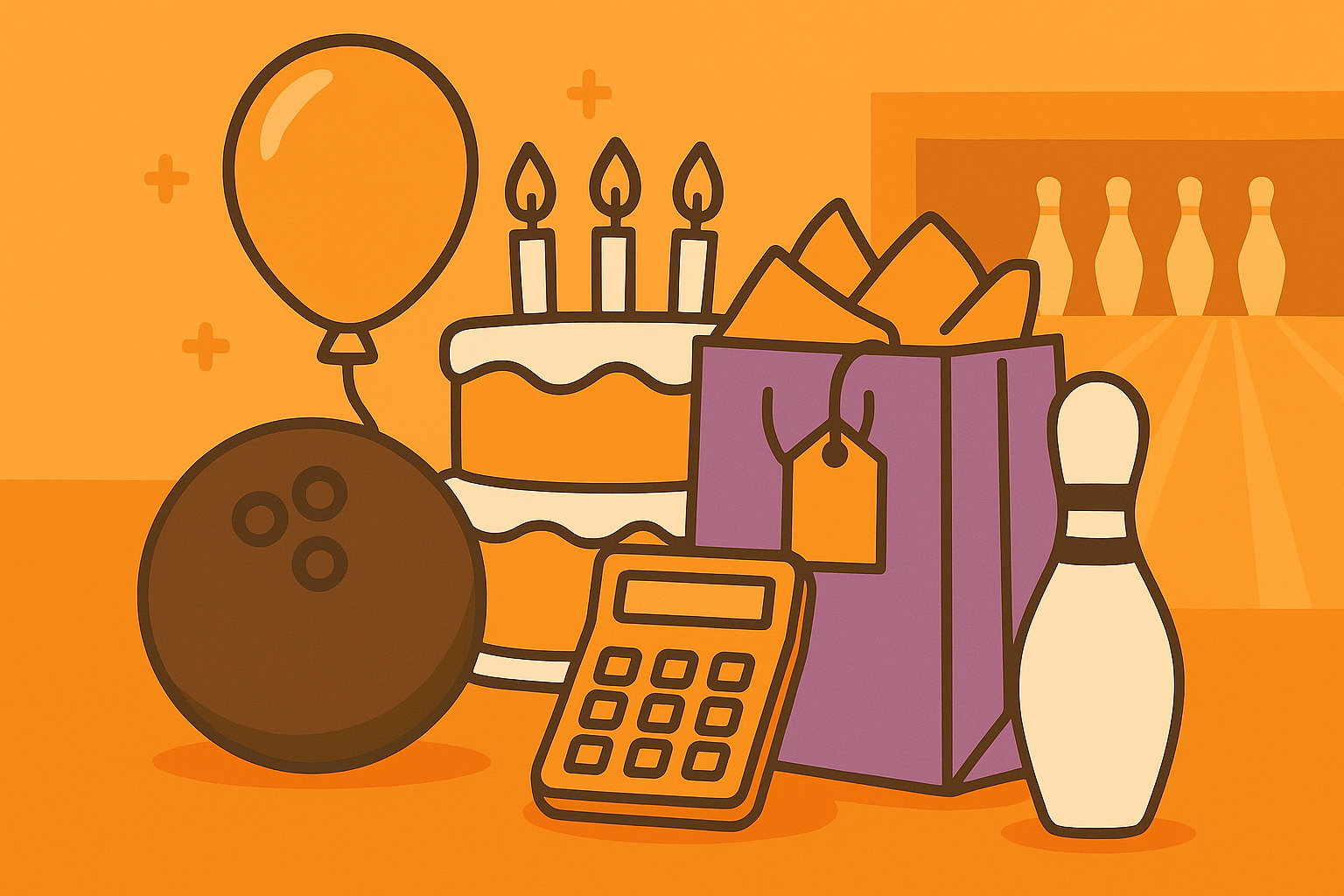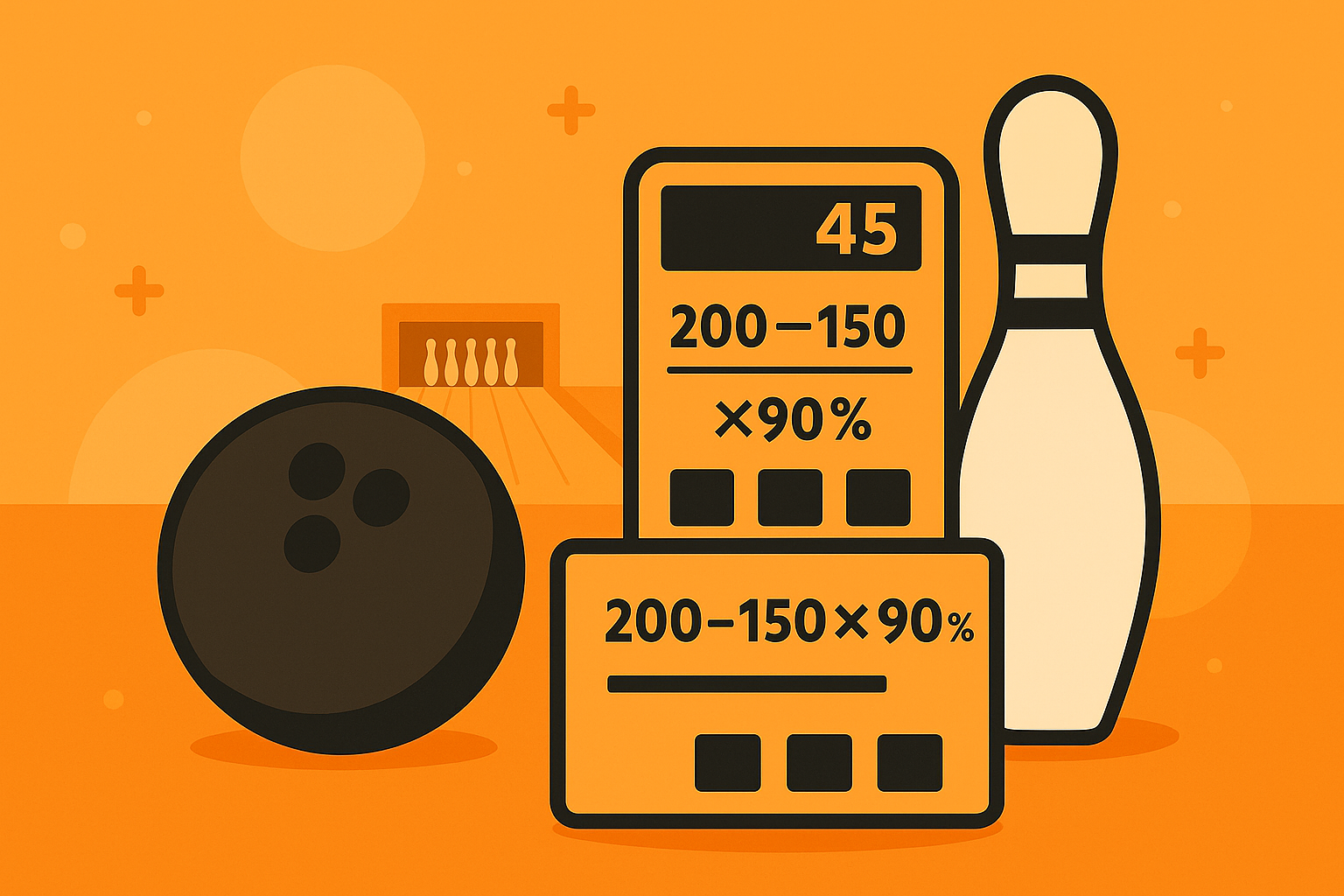The structure of the commonly used bowling balls has three holes, which help the player have a grip while holding the ball. The player holds the ball with his middle, ring, and thumb finger and then throws the ball.
The balls come in a varied range of sizes, depending upon the type of pins they hit. When it comes to weight, there are two different kinds called high mass and low mass balls.
High Mass: These are the weight blocks that are placed near the shells.
Low Mass: These balls are of different shapes and sizes. They are kept in between the bowling balls.
THERE ARE DIFFERENT TYPES OF BOWLING BALLS AS STATED BELOW:
Tenpin ball: These balls are the commonly used bowling balls with three holes in them which are used for knocking the ten pins.
Duckpin bowling ball: This type of ball is smaller in size, around 4.75–5.00 inches in diameter without any holes and the pins that are knocked with this ball are 60% smaller than the regular pins.
Candlepin bowling ball: This ball has no holes and is the smallest of all, weighing around 2 lbs. The pins that it knocks are way smaller than the original one; in addition, this ball knocks down only five pins in a game.
In this article we will go in detail on what bowling balls are made of, their background, different types of bowling balls, modern day bowling balls, and some common FAQs.
HISTORICAL BACKGROUND ON BOWLING BALLS
The emergence of bowling is believed to be in Egypt after finding the carving of this game on the Egyptian royal tomb in 5200 BC. The carving depicted women and men holding a ball and targeting 9 uniquely shaped wood sticks. One of the interesting findings by a British anthropologist in 1930 was when he found bowling pins made out of wood were buried in the grave of a child in Egypt thousands of years ago. After this incident, many anthropologists started finding many wooden things that resembled a bowling pin in different parts of Egypt. Later the bowling game was invented and introduced to people from various countries.
Back then, the ball and the pins were made out of Lignum vitae, a hardwood. This type of bowling ball was being used for playing in different types of lanes. These wooden balls were made in different sizes and varied in weight based on the power of the bowler. For example, heavily built men used balls that weigh 20 pounds, whereas kids used balls less than 5 pounds.
Later in the year 1905, a bowling ball was created with heavy rubber material by the Brunswick Corporation, which is a very famous manufacturing company, and these balls were used till the year 1980. This was when the evolution of the modern bowling ball started.
In the 1980s, balls were made out of urethane which was famously known as the aggressive ball. Then from the 1990s, different balls were made out of polyester and plastic, which are now used as spare balls. These spare balls are used as the second ball while bowling when the bowler fails to hit all the pins in the first shot. These balls are designed for giving straight shots to hit the remaining pins without any high hooks.
To date, bowling has been played as a stress-relieving game. In the year 1988, bowling was demonstrated in the Olympics, where 20 nations competed against each other in a demonstration game.
However, in the end, no medals were given as it was not an official game, then the Olympics authorization decided not to add bowling as an Olympic game.
Then finally, reactive resins were added to the main ball, which gave higher hooks.
HAS THE INTERIOR OF A BOWLING BALL EVER BEEN MADE OF STONE AT ANY TIME IN ITS HISTORY?
The first known bowling ball is very famous for its material called Lignum vitae which is a very hard form of wood. From the very beginning, people started bowling with ninepins with the same kind of ball, and later this was banned in a few countries as it was a distraction for soldiers.
After many years this game was played again by adding one more pin making it a tenpin game. The Brunswick company introduced rubber balls in the later period which was very famous for a decade. In the history of bowling ball’s evolution, they were made of rubber, wood, plastic but never with a stone.
So “No,” the interior of a bowling ball has never been made of stone at any time in its history.
WHAT ARE MODERN-DAY BOWLING BALLS MADE OF?
Modern bowling balls are made out of plastic or polyester among which plastic balls are famous among all the category of people because the spare balls are much more comfortable as they give straight line hits.
These balls faced a lot of problems in the 1970s due to their less friction nature. Plastic balls that replaced the rubber balls started to slip easily on the oily lanes laid based on the modern rules, and many professionals faced many serious issues.
These balls gave straight shots but failed to make any hooks on the lane, resulting in a reduced score for the professionals. In the 1980s, this problem was solved after introducing urethane bowling lanes which were adopted by many countries due to its cheaper price. This made the manufacturers make balls made out of urethane which had better friction control than the plastic balls and gave perfect hooks. Hence people started using this urethane ball for their first shot to get strike by knocking all tenpins. These balls became famous instantly because of their simple maintenance and high strike rate. The popularity of urethane balls is still constant till date.
In the later period manufacturers created reactive resin balls to spice up the game play. These balls were made by following the same base structure of the urethane ball. The reactive resin ball became very famous for its aggressive nature during the game. The aggressiveness of the ball was created due to the heavy porousness on its coverstock which creates high friction on the lane.
Experienced players use this ball while playing a big match to increase or maximize their efficiency and to give aggressive game play.
WHAT DOES A BOWLING BALL COVERSTOCK DO?
In a game, winning chances are dependent upon the player and the quality and types of the ball being used. The coverstock and weight block of the ball are two major things that decide the game’s efficiency.
The type of coverstock is more important in a ball, just like how a player needs max strength while playing because this impacts the whole game. So the player needs to choose a ball based on its coverstock.
These coverstocks are the outer layer of the ball that decides the roll of the ball. The character of the coverstock is to cut the oil if it is an oily lane to create resistance or create friction if it is a dry lane when the ball is thrown to have a proper hook to hit all the pins.
If one did not pick the right coverstock ball for a proper lane, the hook potential reduces. The ball either hits randomly or goes to the extreme corners. Rarely are there chances for a ball to die if one picks a wrong ball for a dry lane.
Various materials have been used as a coverstock which has individual advantages and disadvantages.
TYPES OF BOWLING BALL COVERSTOCKS
When you roll a bowling ball down the lane, the friction that comes between the ball and the lane is a result of the type of ball or coverstock used. If there is more friction between the ball and the surface of the lane, it means there is more hook potential. And the amount of friction created is dependent on the type of coverstock.
Bowling balls are made up of four types of coverstock and they are:
- Plastic
- Particle (Proactive)
- Urethane
- Reactive Resin
PLASTIC
The smooth surface of plastic helps in effectively reducing the hook potential because it brings down friction substantially. For beginners, this will be the best type of ball, since they might prefer to have a ball that fits their hand perfectly. Other players might use this to shoot spares or for practice.
PARTICLE (PROACTIVE)
Particle or proactive coverstock balls are used mostly by expert players. It generates high friction. This is because they are bumpy and have a rough surface. One might say that a proactive coverstock is like a ‘snow tire, with chains.’ It can even dig into heavily oiled lanes and grounds. This comes highly recommended for all advanced players.
URETHANE
Urethane balls are probably the step ahead after plastic balls since they have more hook potential than plastic balls, but lesser than resin or particle coverstock balls. They are quite durable. It produces increased friction, which makes sure the ball does not deflect often and allows for good pin action. This can be a good choice for someone looking to upgrade from the basic plastic coverstock.
REACTIVE RESIN
Reactive resin coverstock provides better friction, hook potential and pin action compared to both plastic and urethane coverstock. Since they produce high friction, they are a bit difficult to control. Their movement can be affected by the conditions of the lane and the actions of the bowler. This makes this a ball that is suited for professional and expert players. It is used extensively by those seeking lane reactions and hook activity. The only downside of this coverstock is that it does not last very long.
WHAT IS INSIDE OF A BOWLING BALL – TYPES OF BOWLING BALL CORES
Firstly, the core of a bowling ball is made by adding heavy substances like bismuth graphite to resin to create a dense type of plastic, or to a ceramic material.
Understand that bowling balls are not just spheres. There are different types of bowling ball cores and they come in different shapes and sizes. Here, we will classify them into three types namely:
- Pancake cores
- Symmetrical cores
- Asymmetrical cores
PANCAKE CORES
True to its name, a pancake looks like a pancake. Or at least like a small disk or hockey puck. You can find them in most urethane and reactive resin balls. They sit on one portion of the ball, and their main function is to balance all the mass lost when holes are drilled into the ball. This type of core is very common. This is only because it is the most reliable and has been tried and tested over time by players and is most preferable to them.
SYMMETRICAL CORES
The next type of core is the symmetrical core. These are large cores that don’t have a high intermediate differential. Symmetrical cores were designed when makers wanted to move away from pancake cores and make balls with better performance. Symmetric cores allow for more finger-hole formations. They also provide better hook potential.
ASYMMETRICAL CORES
Asymmetrical cores have a high intermediate differential. They can be in different shapes like cylinders or semi-circles. They provide high friction, compared to symmetrical cores that give a smooth motion for the most part. One drawback, however, is that their balance and quality can get affected easily by finger hole formations.
SPECIFICATIONS OF A BOWLING BALL
A few more basic but important specifications must be noted while buying or producing a bowling ball. The United States Bowling Congress (USBC) has given some guidelines regarding how a bowling ball should be. Hence, any manufacturer who produces these balls must be approved by the USBC; else, they cannot manufacture and distribute the balls to the public.
Here are some specifications that are listed by United States Bowling Congress:
- The bowling ball should only be made out of solid material, and it should not consist of any liquid or have a void in the middle.
- Material that is said to be used as coverstock should be spread equally on the whole coverstock.
- Any method of altering to increase the weight or different pattern on the surface for friction is prohibited.
- No chemical or solvents can be used on the surface of the ball for alteration.
- If sand is used for finishing, it must be used on the whole surface of the ball, and no foreign material should be included.
- The weight of the ball must not exceed more than 16 pounds, and the diameter of a 13lbs or greater weight ball shall be a minimum of 8.5 or a maximum of 8.59
- The circumference of a 13lbs or greater weight ball shall be a minimum of 26.7 or a maximum of 27.002.
- The roundness of a 13lbs or greater weight ball can be .01 tolerances.
- The RG of a 13lbs or greater weight ball can only be .06.
- There can be a maximum of five finger holes, and the diameter should not exceed more than 11/4 cm.
- One vent can be drilled, and its diameter cannot exceed more than ¼ diameters.
- The bowling ball can be made out of any color or pattern unless the coverstock material is evenly spread throughout the coverstock surface.
- Adding plugs are allowed just in case of re-drilling a bowling ball.
DO BOWLING BALLS FLOAT?
Have you ever thought, why does a penny sink but many things float? People have experimented with a bowling ball to see if a bowling ball can float in water or not because it is a very heavy substance, and they got a surprising result. The result said that a few bowling balls float depending upon their density and volume.
Ball weighing less than 12 pounds floats and heavier than 12 pounds sinks in the water. To put it simply, Archimedes Principle states that the buoyant force exerted on a fluid is equal to the weight of the fluid displaced. So it says when an object is placed on the water, it displaces its weight in water. For example, when you drop a 12-pound ball in the water, it displaces its weight or even a little bit more.
CONCLUSION
In the end, we got to know the whole evolution process of the bowling ball made from hardwood to plastic/polyester. The whole improvement in the technology has helped the creators to make these balls with different chemicals and structural patterns to get the best form of a ball for a classy game.
All the above-mentioned balls have very small differences in them that are used for different purposes for different types of bowling games. This proves that even a small difference can be quite impactful in the game.
Hope the article was very informative, giving you a glimpse of how a bowling ball is made, it’s magical history and evolution over the time.
FREQUENTLY ASKED QUESTIONS
Here are some frequently asked questions about bowling balls:
WHAT TYPE OF CLEANING SUPPLIES CAN I USE FOR CLEANING BOWLING BALLS?
All the bowling lanes are lathered with oil to help the ball move smoothly and speedily through the lane, so after every throw, it is important for you to wipe the grease out of your ball. For properly cleaning the bowling ball, use a ball cleaner and wipe it off with a damp microfiber towel. If you don’t get a ball cleaner, you can make one by adding equal parts of isopropyl alcohol, water, and all-purpose cleaner to spray on the ball.
WHAT TYPE OF BOWLING BALL SHOULD I GET?
People say that your bowling ball should be about 10 percent of your total body weight, which is up to and about 16 pounds. The thing is, most pro bowlers use 16-pound balls, which is more than those that use the 15 pound balls. Another way to determine the type of bowling ball you should use is to add one or two pounds to the weight of the house ball you usually use.
WHAT BOWLING BALL WEIGHT SHOULD I USE?
Like has been mentioned above, you should use the 10% rule. This means that a bowling ball should only weigh about 10 percent of your total body weight. What this means is that if your total body weight is 150 pounds, you should not use an 8-pound ball. Instead, you use a 15-pound ball. Also, your ball should not be so heavy that it makes you uncomfortable. You want power and control.
WHAT COVERSTOCK HOOKS THE MOST?
The coverstock that hooks the most is the particle (proactive) coverstock. This ball is like snow tires covered in chains. This makes for the best hooks between the ball and the surface of the lane. This type of coverstock is usually used only by the more seasoned bowlers.
WHAT IS THE BEST BOWLING BALL FOR A HOOK?
There are many bowling balls that hook well and some of them are:
- Brunswick Rhino Metallic Bowling Ball
- Hammer Black Widow Bowling Ball
- Motiv Trident Bowling Ball
- Motiv Forge Bowling Ball
- Brunswick Deep Space Bowling Ball
HOW OFTEN SHOULD I BUY A NEW BOWLING BALL?
Every ball must be handled and maintained with care by cleaning it after every game and rolling it in a proper lane which is not hard for the ball. One can change or buy a new ball once every 5 – 10 years. This differs from person to person based on the quality of the ball and how many times the person bowls. If you are the person who plays this game every single day, then it is advisable to change it in 5 years.







